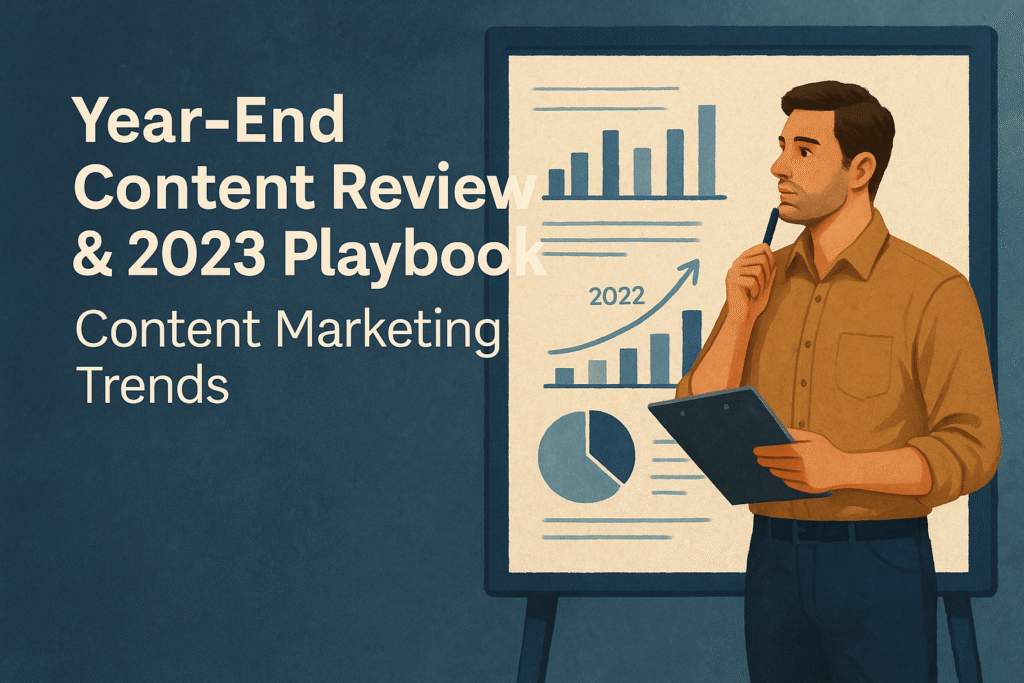As 2022 draws to a close, the smartest brands are looking backward and forward at the same time. A well-structured year-end content review isn’t just a victory lap—it’s the foundation for a stronger, more intentional 2023. This is the moment to analyze what performed best, refresh high-value assets, and blend insights with bold predictions that capture both audience attention and search equity.

Refreshing old content can be a powerful growth lever. According to Ahrefs, updating top-performing assets can boost organic traffic by up to 111%. This is not simply about fixing typos or swapping images—it’s about re-optimizing for today’s keywords, aligning with current search intent, and reinvigorating content that has already proven its ability to attract and convert.
Future-facing content has its own unique advantage. BuzzSumo reports that posts projecting trends and predictions earn 50% more backlinks than average. That makes the combination of a retrospective and a forecast an especially potent mix for marketers who want their year-end content to both perform in the moment and accrue authority over time.
B2B vs. B2C Applications
For B2B marketers, a December content audit is a chance to refine lead-generating resources. Aligning whitepapers, case studies, and service pages with the evolving buyer journey ensures that what’s visible in search also speaks to current decision-maker priorities. Repurposing and refreshing evergreen assets keeps the content pipeline full without overextending resources in Q1.
B2C brands benefit from weaving emotional resonance into their year-end content. Nostalgic “look back” moments paired with forward-looking trend predictions spark both immediate engagement and long-term link-building. Interactive formats—such as clickable timelines, quizzes, or embedded data visualizations—turn casual readers into active participants, amplifying shareability and brand recall.
Factics: Data + Tactics
– Fact: Refreshing top 20% of content before year-end can boost organic traffic by up to 111% (Ahrefs).
Tactic: Audit your highest-traffic or highest-converting pages. Update data, visuals, and CTAs to maintain relevance and capture new queries.
– Fact: Future-facing posts earn 50% more backlinks (BuzzSumo).
Tactic: Blend 2022’s highlights with 2023 predictions. This dual approach builds topical authority and attracts inbound links from media and industry sources.
Retention hooks, such as interactive year-in-review timelines and embedded charts, keep visitors engaged longer and encourage repeat visits. Internal linking to all prior 2022 posts strengthens your content cluster, signaling topical depth to search engines and improving rankings for your key terms.
Best Practice Spotlight
Ahrefs consistently demonstrates how methodical content refreshing can yield exponential gains. Their approach—prioritizing proven performers, systematically updating them, and republishing for renewed visibility—sets a standard for year-end optimization. Similarly, top content marketing practitioners merge backward-looking reviews with forward-facing predictions to position themselves as both reflective and forward-thinking voices in their niche.
At little off our normal topic, but check out this video to help you reset for 2023, Strategy vs Planning
Hypotheticals Imagined
1. SaaS Company Year-End Audit
Background: A B2B SaaS company targets the finance sector. December is dedicated to auditing and refreshing its top-performing 2022 blog posts, updating industry data, case study results, and CTA offers.
Execution: The refreshed content is paired with 2023 feature previews and linked from the April “Content Funnel” post to boost both topical relevance and authority.
Expected Outcomes: 40% increase in organic traffic and a noticeable uptick in qualified demo requests in Q1.
Pitfalls: Overemphasis on product features without tying them to audience needs can weaken engagement.
2. Lifestyle Brand’s Interactive Recap
Background: A B2C lifestyle brand in fashion and wellness wants to own the conversation heading into January.
Execution: Creates an interactive “2022 in Review” timeline featuring top social posts, campaign highlights, and customer stories, paired with trend forecasts for spring/summer 2023.
Expected Outcomes: 60% increase in social shares, 35% more backlinks, and stronger brand affinity.
Pitfalls: Poor mobile rendering can frustrate users and limit shareability.
3. Marketing Agency Internal Linking Play
Background: A digital agency wants to maximize the authority of its 2022 content portfolio.
Execution: Consolidates all 2022 blog content into a well-structured internal linking cluster, with the December review as the central pillar page.
Expected Outcomes: Higher keyword rankings for “content marketing trends” and related terms, plus improved organic lead generation.
Pitfalls: Failing to update outdated claims or sources before linking can erode trust with both users and search engines.
References
Ahrefs. (2022). How refreshing old content can boost organic traffic. https://ahrefs.com/blog/how-to-increase-organic-traffic/
BuzzSumo. (2020). How to boost SEO using the BuzzSumo backlink analysis tool. https://buzzsumo.com/blog/using-the-buzzsumo-backlink-analysis-tool-to-boost-seo/
Content Marketing Institute. (2023). 80+ trends in content marketing for success in 2023. https://contentmarketinginstitute.com/content-marketing-strategy/80-trends-in-content-marketing-for-success-in-2023
Digital Marketer. (2023). Top digital marketing trends to know for 2023. https://www.digitalmarketer.com/blog/digital-marketing-trends-2/
NYTLicensing. (2023). 15 content marketing objectives to prioritize in 2023. https://nytlicensing.com/latest/marketing/content-marketing-objectives-to-prioritize/
Leave a Reply
You must be logged in to post a comment.